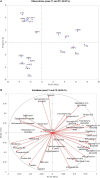Leaf Polyphenolic Profile as a Determinant of Croatian Native Grapevine Varieties' Susceptibility to Plasmopara viticola
- PMID: 35360327
- PMCID: PMC8963502
- DOI: 10.3389/fpls.2022.836318
Leaf Polyphenolic Profile as a Determinant of Croatian Native Grapevine Varieties' Susceptibility to Plasmopara viticola
Abstract
Since grapevine is highly susceptible to various pathogens, enormous amounts of pesticides are applied each season to achieve profitable production. One of the most destructive grapevine diseases is downy mildew, and their interaction has been in the spotlight for more than a decade. When it comes to a metabolome level, phenolic compounds are relevant to investigate due to their involvement in the plant immune system and known antifungal properties. Croatian grapevine germplasm is highly heterogeneous due to its long history of cultivation in diversified geographical regions. Since it has been found that native varieties react differently to the infection of Plasmopara viticola, the intention of this study is to define if the chemical background of the leaves, i.e., polyphenolic composition, is responsible for these dissimilarities. Therefore, the leaves of 17 genotypes, among which 14 were native and 3 were controls, were analyzed using high-performance liquid chromatography (HPLC) in four terms: before inoculation and 24, 48, and 96 h post inoculation (hpi). During this early phase, significant differences were found neither between the terms nor between the non-inoculated and inoculated samples, except for resveratrol-3-O-glucoside. By applying principal component analysis (PCA) using initial leaf polyphenolic composition, varieties of V. vinifera were clearly separated into three different groups corresponding to their International Organization of Vine and Wine (OIV) classes of susceptibility to P. viticola. Results obtained in this research suggest that the initial constitutive polyphenolic composition of the cultivar leaves has a crucial influence on their susceptibility to P. viticola, and this finding can be used to improve the success of grapevine breeding programs toward downy mildew resistance.
Keywords: HPLC; Vitis vinifera L.; chemical composition; defense mechanism; downy mildew; leaves.
Copyright © 2022 Štambuk, Šikuten, Karoglan Kontić, Maletić, Preiner and Tomaz.
Conflict of interest statement
The authors declare that the research was conducted in the absence of any commercial or financial relationships that could be construed as a potential conflict of interest.
Figures


Similar articles
-
Croatian Native Grapevine Varieties' VOCs Responses upon Plasmopara viticola Inoculation.Plants (Basel). 2023 Jan 15;12(2):404. doi: 10.3390/plants12020404. Plants (Basel). 2023. PMID: 36679116 Free PMC article.
-
Screening of Croatian Native Grapevine Varieties for Susceptibility to Plasmopara viticola Using Leaf Disc Bioassay, Chlorophyll Fluorescence, and Multispectral Imaging.Plants (Basel). 2021 Mar 30;10(4):661. doi: 10.3390/plants10040661. Plants (Basel). 2021. PMID: 33808401 Free PMC article.
-
Grapevine Rpv3-, Rpv10- and Rpv12-mediated defense responses against Plasmopara viticola and the impact of their deployment on fungicide use in viticulture.BMC Plant Biol. 2021 Oct 14;21(1):470. doi: 10.1186/s12870-021-03228-7. BMC Plant Biol. 2021. PMID: 34649524 Free PMC article.
-
Plasmopara viticola the Causal Agent of Downy Mildew of Grapevine: From Its Taxonomy to Disease Management.Front Microbiol. 2022 May 11;13:889472. doi: 10.3389/fmicb.2022.889472. eCollection 2022. Front Microbiol. 2022. PMID: 35633680 Free PMC article. Review.
-
Modifications of Grapevine Berry Composition Induced by Main Viral and Fungal Pathogens in a Climate Change Scenario.Front Plant Sci. 2021 Dec 8;12:717223. doi: 10.3389/fpls.2021.717223. eCollection 2021. Front Plant Sci. 2021. PMID: 34956249 Free PMC article. Review.
Cited by
-
Croatian Native Grapevine Varieties' VOCs Responses upon Plasmopara viticola Inoculation.Plants (Basel). 2023 Jan 15;12(2):404. doi: 10.3390/plants12020404. Plants (Basel). 2023. PMID: 36679116 Free PMC article.
References
-
- Addinsoft (2020). XLSTAT Statistical and Data Analysis Solution. New York, NY: Addinsoft.
LinkOut - more resources
Full Text Sources

